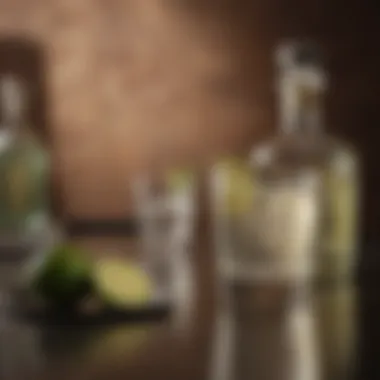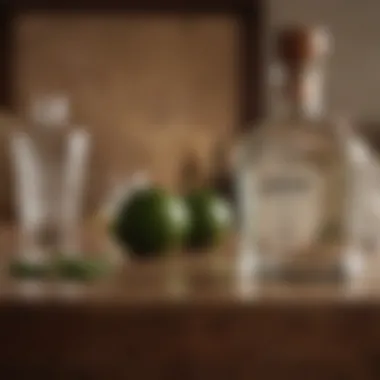Understanding Patron Alcohol Percent: A Deep Dive


Intro
Patron is a tequila brand that has gained significant recognition within various social settings. Beyond its popularity, understanding the alcohol content in different varieties of Patron is essential for responsible consumption and appreciation of its flavors. This article will explore the alcohol percentages found in Patron, delve into its various types, and discuss their implications both for enjoyment and health.
The nuances in alcohol content go beyond mere numbers. For consumers, discerning the effects of different alcohol levels can enhance their drinking experience and food pairing opportunities. This examination will also touch upon how Patron is produced, the legal aspects of alcohol content, and considerations for health-conscious consumers who are inquisitive about their choices.
Here, we aim to illuminate how the alcohol percentage correlates with sensory experiences, thus enriching the overall understanding of Patron. With careful attention to detail, this guide hopes to strike a balance between informative content and practical application, serving the needs of food enthusiasts.
Recipe Overview
Dish Description
While we are not presenting a traditional recipe, each variety of Patron can be paired with a selection of complementary dishes. Each type of tequila has unique flavor profiles that can enhance or contrast with certain culinary styles. For instance, the smoothness of Patron Silver may work well with clean, fresh flavors, while the rich, oak notes of Patron Añejo pair beautifully with hearty dishes.
Cuisine Type
The rich heritage of tequila like Patron connects to traditional Mexican cuisine but does not end there. The versatility of Patron allows it to interact harmoniously with various global flavors. Pairing options can be expansive, ranging from Mexican street tacos to Italian-inspired antipasto boards.
Understanding Alcohol Percent in Patron
Patron offers several expressions that vary in alcohol percentage. The most common ones are Patron Silver, Patron Reposado, and Patron Añejo. Each brings a distinct character to the table:
- Patron Silver: Typically contains 40% alcohol by volume (ABV). Known for its crisp taste with fresh agave notes, it serves as a versatile base for cocktails.
- Patron Reposado: Aged for at least two months, this variant also has around 40% ABV. The aging process imparts hints of oak and spice, enhancing its complexity.
- Patron Añejo: Aged for over a year, this tequila maintains a 40% ABV. The depth in flavor is more pronounced, bringing caramel and vanilla notes, perfect for neat sipping or premium cocktails.
"Understanding the alcohol content is essential to appreciate the full range of flavors each Patron variety has to offer."
Each of these variations can influence not only the drinking experience but also the taste of food being served alongside them. By recognizing how each type interacts with different ingredients, consumers can make informed choices that elevate their culinary exploits.
Production Process and Alcohol Content
The method of production for Patron tequila is significant in determining the final alcohol content. The fermentation and distillation process are crucial stages. During fermentation, yeasts consume the sugars in the agave, which in turn produces alcohol. Distillation helps in concentrating these alcohol levels to achieve the desired taste and strength.
The final alcohol percentage is also affected by the taxation policies in place regarding spirits. Different countries may have varying regulations that can influence how alcohol percentages are marketed and consumed. This aspect is particularly important for consumers looking to enjoy Patron responsibly.
As consumers become more educated regarding alcohol percentages, they can better appreciate Patron's range and characteristics. This understanding extends to making informed choices when paired with food and beverages.
Prelude to Patron Tequila
Patron tequila represents not just a brand but a significant aspect of the global spirits market. Understanding Patron is essential for anyone interested in quality spirits, particularly tequila. Patron manages to stand out in a crowded field by adhering to high standards in production and being deeply rooted in tradition.
The exploration of Patron is particularly relevant when addressing alcohol percentages. Variations in alcohol content play a vital role in overall flavor and consumer experience. Knowing these aspects helps drinkers make informed choices. The significance extends to culinary contexts as well, where the right pairing can enhance both food and drink.
Patron's careful attention to quality and its varied range of products—like Patron Silver, Reposado, and Anejo—can directly influence flavor profiles, making it an intriguing subject for enthusiasts. The alcohol percent, identified as Alcohol by Volume (ABV), often dictates how one appreciates the tequila's offerings. The upcoming sections will detail these components, ensuring readers grasp the nuances of Patron tequila and its accompanying alcohol metrics.
Brief History of Patron
Patron tequila dates back to 1989, founded by John Paul DeJoria and Martin Crowley. Their aim was to create a high-quality tequila targeting the premium market. Production began in the Highlands of Jalisco, Mexico, where the agave plants thrive under specific conditions. The founders emphasized traditional methods, using hand-harvested agave and traditional distillation methods.
From its inception, Patron was positioned as a luxurious option in the spirits industry. The product gained quick popularity, attributed largely to its smooth taste and aesthetic presentation. Over the years, Patron expanded its offerings to include various types of tequila, catering to a broader audience.
"Patron was one of the first brands that elevated tequila, turning it from a party drink into a spirit enjoyed neat or in high-end cocktails."


As Patron grew, so did its reputation. The brand cultivated a strong community among enthusiasts and gained recognition through awards and accolades. This historical context is key to understanding the product's place in the spirits landscape today.
Patron's Reputation in the Spirits Industry
Patron's reputation is one of premium quality and exclusivity. It has established itself as a leader in the tequila market, often synonymous with luxury. Enthusiasts regard Patron as a benchmark by which other tequilas are measured.
The brand invests heavily in both marketing and production quality, which contributes to its esteemed position. Consumer loyalty is also significant; many patrons consistently choose Patron over other brands.
Patron's presence extends to bars and restaurants globally. Its branding and packaging reflect sophistication, making it a popular choice for cocktails and mixers. This strong reputation influences perceptions and consumption trends in the spirits market, reinforcing the brand's integrity over time.
Understanding Alcohol Percentages
Understanding alcohol percentages is key to grasping the essence of Patron and other spirits. This knowledge serves several purposes. It allows consumers to make informed choices about their alcohol consumption. Additionally, being aware of alcohol content can enhance one's drinking experience. Different drinks with varying alcohol percentages can offer diverse aromas and flavors, affecting one’s overall enjoyment.
Alcohol by Volume, or ABV, stands as the standard measurement of alcohol content in beverages. It is expressed as a percentage, indicating how much of the total volume is pure alcohol. In simpler terms, it quantifies the strength of the drink. Understanding this metric is fundamental for anyone wanting to appreciate tequila and other spirits properly.
Defining Alcohol by Volume (ABV)
Alcohol by Volume (ABV) is a critical concept in the realm of spirits. It refers to the percentage of alcohol present in a beverage compared to its total volume. For example, a tequila with 40% ABV consists of 40% pure alcohol in every 100 milliliters of liquid. This measure is universally accepted, making it easier for consumers to compare the strengths of different spirits.
The ABV can vary widely depending on the drink. Most tequilas, including Patron, typically contain an ABV ranging from 35% to 55%. Understanding this allows drinkers to gauge how potent a particular type of Patron is. This knowledge is vital for both casual drinkers and connoisseurs, as it impacts not only enjoyment but also safety. If you’re unsure about how a high ABV spirit might affect you, it’s essential to consult resources like Wikipedia.
How ABV Influences Taste and Experience
The ABV of a spirit significantly influences its taste and overall drinking experience. For instance, a higher ABV generally leads to a more pronounced alcohol flavor. While some may prefer the robust nature of a high-alcohol drink, others might find it overpowering. When tasting Patron, understanding ABV helps to prepare your palate.
Moreover, different ABV levels can alter the complexity of flavors. A Patron tequila with lower ABV might allow for more subtle notes to shine through. In contrast, higher ABV options could emphasize bold characteristics. These variations directly affect the drinking experience, as they can highlight or mask certain flavor profiles.
Here are some considerations for appreciating how ABV plays a role in taste:
- Flavor Balance: A balanced flavor profile can be achieved with moderate ABVs.
- Mixing: Higher ABV drinks might require careful mixing in cocktails to achieve taste harmony.
- Food Pairing: Understand the body and weight of the spirit when pairing with food, particularly when you want to complement or contrast flavors.
"Knowledge of ABV aids in selecting the right type of Patron that would suit your taste preferences, enhancing both flavor appreciation and enjoyment."
In summary, understanding alcohol percentages is not just an academic exercise. It is an essential component for anyone who wishes to enjoy Patron tequila fully. An awareness of ABV allows for more informed choices in both consumption and culinary pairings.
Patron Alcohol Percent Breakdown
Understanding the alcohol percent in Patron tequila is crucial for several reasons. First, it allows consumers to make informed choices regarding their consumption. Different types of Patron have varying alcohol levels, which affects not only the flavor but also the overall drinking experience. Knowing the alcohol content can also aid in responsible drinking and understanding one's tolerance levels. Moreover, it is essential for pairing with food, as the alcohol percentage can complement or clash with certain flavors.
Patron Silver's Alcohol Content
Patron Silver is known for its clear, unaged profile, characterized by its crisp and fresh taste. It typically has an alcohol content of 40% ABV (80 proof), reflecting the standard for most tequilas. This level of alcohol content is significant because it retains the natural agave flavors while allowing for a smooth finish. Consumers appreciate this tequila for its versatility, making it ideal for sipping or mixing in cocktails. It is recommended to pair it with light dishes like ceviche or fresh salads, enhancing the dining experience.
Patron Reposado Alcohol Percent
Patron Reposado is aged for a minimum of two months in oak barrels, which gives it a golden hue and a more complex flavor profile. Its alcohol content also sits at 40% ABV. The aging process contributes subtle notes of oak, vanilla, and spices, making it a favorite for those who enjoy a richer taste in tequila. This variety can be enjoyed neat or used in cocktails. It pairs wonderfully with richer foods, such as grilled meats, where its flavors can stand up to hearty dishes.
Patron Anejo's Alcohol Strength
Patron Anejo is aged for at least one year in oak barrels and boasts a deeper color and flavor complexity. Like its counterparts, it has an alcohol content of 40% ABV. However, the aging process adds layers of caramel, nut, and dried fruit flavors, making it a more robust choice. This tequila is often regarded as a sipping tequila, best enjoyed alone to appreciate its sophisticated profile. Its richness also works well with more intense flavors, such as dark chocolate or strong cheeses.


Patron Extra Anejo: The Premium Variant
Patron Extra Anejo is reserved for those who seek a premium experience. Aged for more than three years in oak barrels, it contains an alcohol level of 40% ABV. This extended aging results in a deep, complex spirit, rich with flavors of dried fruits, spices, and a hint of smokiness. The Extra Anejo is ideal for sipping, allowing drinkers to fully appreciate the intricate flavor profile. When considering food pairings, it complements dishes like smoked meats or aged cheeses perfectly, enhancing the overall culinary experience.
In summary, each variant of Patron tequila presents unique characteristics tied closely to its alcohol content. Understanding these details not only enriches one's appreciation for tequila but also ensures a more informed and enjoyable drinking experience.
Tequila Production and Its Impact on Alcohol Content
Understanding tequila production is pivotal for comprehending the nuances of alcohol content in Patron and other tequilas. The process of making tequila is intricate, and it influences everything from flavor profiles to alcohol percentages. This section will analyze the production methods and how they impact the final product's alcohol percentage.
The Tequila Making Process
Tequila is created primarily from the blue agave plant, which is native to Mexico. The journey begins with the harvesting of mature agave plants. This plant takes about seven to ten years to mature before it can be harvested. Once harvested, the piñas, or hearts of the agave, are roasted in ovens or autoclaves. This step converts the complex carbohydrates found in the agave into fermentable sugars.
After roasting, the agave is crushed to extract the sweet juice. This juice undergoes fermentation, often with the addition of yeast, which converts the sugars into alcohol. The fermentation typically lasts for several days, resulting in a liquid known as mosto. This liquid then undergoes distillation, usually twice, to enhance the alcohol potency. The distillation process is crucial as it determines the final alcohol by volume (ABV).
Finally, the tequila is either bottled directly or aged in barrels. The aging process can add different flavors and aromas, but it does not fundamentally change the alcohol content. The alcohol content for Patron varieties stays consistent through these stages, often ranging from 35% to 55% ABV.
Factors Influencing Alcohol Content in Tequila
Several factors can influence the alcohol content of tequila, beyond the production process. Understanding these factors helps in making informed choices when selecting a Patron product.
- Yeast Strain: Different strains of yeast can yield different alcohol levels during fermentation. Some yeast strains can produce a higher alcohol concentration compared to others.
- Fermentation Time: Longer fermentation can also increase alcohol content. This happens as the yeast consumes more sugars over time.
- Distillation Technique: The method of distillation affects how much alcohol is captured in the final product. High-quality distillation ensures a higher ABV and overall quality.
- Aging Process: While aging does not directly impact alcohol content, it can influence the flavors associated with certain alcohol levels. For instance, Patron Extra Anejo is aged longer than other varieties, which affects its flavor rather than its alcohol percentage.
Health Considerations Regarding Alcohol Consumption
Understanding health considerations related to alcohol consumption is essential when exploring spirits like Patron tequila. Knowledge of how alcohol impacts health may result in better choices for consumers. Increased awareness fosters responsible drinking and improves overall experiences. Alcohol, while enjoyable for many, poses risks that should be evaluated carefully. It's crucial to comprehend the balance between enjoyment and health implications.
Moderation and Responsible Drinking
Moderation is key to enjoying alcohol without adverse effects. The concept of responsible drinking involves knowing one's limits and understanding one's body. Various factors such as body weight, genetics, and health status significantly affect how alcohol is processed.
Health authorities often recommend guidelines, such as:
- For most adults, up to one drink per day for women and two for men can be safe and enjoyable.
- Setting personal limits before indulging in drinking is a wise approach.
- It's vital to listen to one's body and recognize when it's time to stop.
In addition, being aware of situations that may lead to overconsumption, such as social gatherings or stress, can help minimize potential risks. Having a glass of water between alcoholic drinks can also promote moderation.
Health Risks Associated with High ABV Spirits
Alcohol by Volume (ABV) refers to the percentage of alcohol in a drink. High ABV spirits, like certain varieties of Patron, can pose unique health risks.
Common health risks associated with excessive alcohol consumption include:
- Liver Damage: Chronic heavy drinking can lead to liver diseases like fatty liver, hepatitis, and cirrhosis.
- Increased Heart Risk: High consumption can lead to hypertension, heart disease, and stroke.
- Mental Health Issues: Alcohol use can exacerbate anxiety and depression.
- Dependency Risks: The higher the ABV, the greater the potential for developing an addiction.
- Impaired Judgment: Drunk driving or unsafe behaviors can escalate from drinking high-ABV spirits.
Understanding these risks aids consumers in making informed choices about their drinking habits. Informed consumption promotes healthier lifestyles and enjoyable experiences. Consumers should always consider these factors when enjoying Patron or any alcoholic beverage.
Regulatory Aspects of Alcohol Percent in Spirits
Understanding the regulatory aspects of alcohol percent in spirits is essential for consumers and producers alike. Such regulations exist to ensure that consumers have clear information about what they are purchasing. Labeling and tax laws influence the market and create transparency in the alcohol industry. This is especially relevant for a brand like Patron, known for its commitment to quality and integrity.


Labeling Requirements for Alcohol Products
Labeling is a vital part of consumer awareness. The Alcohol and Tobacco Tax and Trade Bureau (TTB) regulates the labeling of alcohol products in the United States. All alcoholic beverages must display relevant information, including the alcohol by volume (ABV) percentage. The ABV provides consumers with an understanding of the product’s strength. Consider the following key labeling requirements:
- Alcohol Content: All labels must include the ABV, stated in a straightforward manner, often expressed as a percentage.
- Health Warnings: Labels are required to have specific health warnings regarding alcohol consumption, such as risks during pregnancy.
- Origin and Ingredients: Many products also indicate the origin of the spirit, which is important for consumers interested in authenticity.
These requirements not only foster informed purchases but also help consumers make choices that align with their preferences and lifestyles.
Tax Implications Based on Alcohol Content
Taxation on alcoholic beverages is often linked to their alcohol content. Higher alcohol content can result in increased tax rates. This has significant implications for manufacturers and consumers. Essentially, the taxation system encourages producers to maintain a balance between quality and affordability. Certain points to consider include:
- Federal Excise Tax: In the U.S., the federal excise tax is based on the ABV. Spirits over 100 proof are taxed at a higher rate.
- State Regulations: Different states have varying tax structures, sometimes imposing additional taxes based on alcohol content, which can affect pricing.
- Market Dynamics: These tax implications can shape retail prices, potentially influencing consumer choices based on budget or drinking habits.
By understanding how tax structures work in relation to alcohol content, consumers can gain better insight into pricing and quality dynamics in the spirits marketplace.
"The way alcohol is taxed and labeled influences not only consumer choice but also the overall perception of quality and value in the alcohol market."
Pairing Patron with Culinary Experiences
When it comes to enjoying Patron tequila, its role transcends mere consumption; it becomes an integral part of culinary experiences. The importance of understanding food pairings with Patron lies not only in enhancing the flavors of the tequila but also in elevating the entire dining experience. The nuances of each Patron variety allow for unique combinations with various dishes, revealing new taste sensations.
The right pairing can enhance the attributes of both the tequila and the food. Considerations may include the flavor profile of the tequila, the textures of the food, and the overall ambiance of the meal. For connoisseurs, exploring these pairings can lead to a deeper appreciation for Patron and its versatile applications within gastronomy.
Recommended Food Pairings for Patron
Patron tequila can be paired harmoniously with a variety of foods. Here are some recommendations based on the different expressions of Patron:
- Patron Silver: This clear tequila, known for its bright and bold flavors, pairs well with light seafood dishes. Consider fresh ceviche or grilled fish, which highlight its citrus notes. It also complements soft cheeses, particularly goat cheese, bringing out the creaminess.
- Patron Reposado: Aged in oak barrels, this tequila develops more complex flavors. It works beautifully with richer foods. Grilled meats such as chicken or pork with a smoky glaze can enhance the oak and spice notes of the tequila. Tacos al pastor, with their combination of sweetness and acidity, are also a great match.
- Patron Anejo: This aged tequila has deep flavors that can stand up to hearty dishes. It pairs well with dishes like braised short ribs or duck confit. Dark chocolate desserts also complement its rich caramels and spice characteristics.
- Patron Extra Anejo: For this luxurious expression, think of pairing it with a gourmet cheese plate. Aged gouda or blue cheese can create an intriguing contrast. Grilled figs or a fruit tart can work well for those seeking an unexpected combination.
Cocktail Recipes Featuring Patron
Crafting cocktails with Patron tequila offers an avenue for creativity and flavor exploration. Here are a couple of cocktails that showcase the unique profiles of the Patron range:
- Patron Margarita: A classic cocktail that remains timeless. Mix:
- Patron Paloma: A refreshing choice especially during warmer months. Combine:
- 2 oz Patron Silver tequila
- 1 oz freshly squeezed lime juice
- 1 oz Cointreau or triple sec Shake with ice and strain into a salt-rimmed glass. Garnish with a lime wheel.
- 2 oz Patron Reposado tequila
- 4 oz grapefruit soda
- Juice of half a lime Pour over ice in a tall glass. Stir gently and garnish with a lime wedge.
Looking to expand horizons? Try these cocktails with variations. Adding jalapeño can spice things up, or experimenting with flavored sodas can yield interesting results. The possibilities with Patron are vast and ripe for exploration.
Ending and Final Thoughts
The exploration of Patron alcohol percentages provides essential insights into not just the product but also the culture surrounding tequila consumption. Understanding the alcohol content in Patron tequila variants is vital. It influences the enjoyment of the spirit, the pairing with different foods, and the decisions made regarding responsible consumption. Each Patron type—Silver, Reposado, Anejo, and Extra Anejo—carries its own distinct alcohol percentage, shaping the overall experience for the drinker.
With this article, we have highlighted fundamental aspects related to alcohol by volume and how it contributes to taste. We delved into tequila production, revealing how each step can influence the final alcohol content. Health considerations remind us of the importance of moderation in consumption, especially with high ABV spirits, as excessive drinking could lead to various health risks. Legal regulations play a crucial role in informing consumers about what to expect on the label. Understanding these regulations enhances the knowledge of what we are actually consuming.
Summarizing Key Points
- Patron's alcohol percentages vary across its different types, offering diverse drinking experiences.
- Awareness of alcohol by volume improves understanding of flavor profiles and what to pair with it.
- Health considerations regarding alcohol consumption stress moderation and responsible drinking.
- Legal and regulatory frameworks ensure consumers are educated about what they buy.
Encouraging Informed Consumption
Responsible enjoyment of Patron and other spirits starts with informed decisions. Consumers should pay attention to the alcohol content indicated on labels, and consider how it may impact their overall experience. It is advisable to understand one’s own limits and drink in moderation.
Engaging with Patron in a responsible manner not only preserves health but also celebrates the intricate craftsmanship behind the spirit. Knowledge leads to a deeper appreciation, allowing enthusiasts to savor the complexities of each sip—be it neat, on the rocks, or as part of a carefully crafted cocktail. Thus, narrows the gap between casual enjoyment and knowledgeable appreciation, making every drink not just a refreshment but a nuanced experience.







